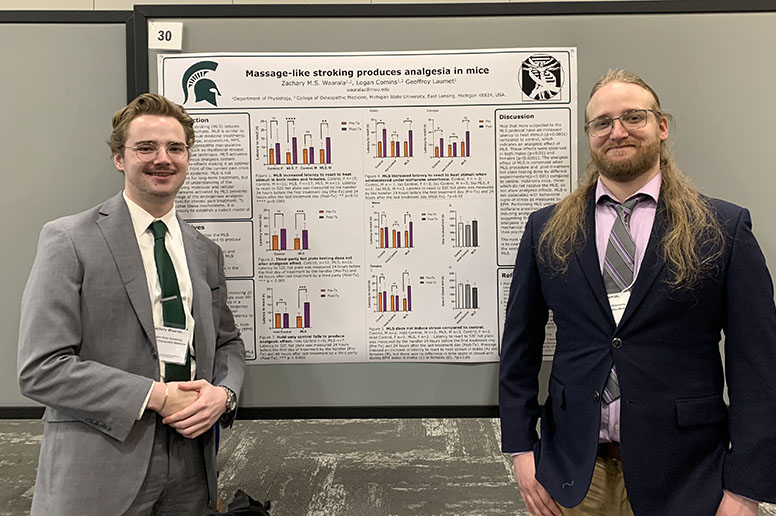
In the first of a series of studies, Zach Waarala, a third-year medical student at the Michigan State University College of Osteopathic Medicine, decided to dive deeper into one of the first things he learned in medical school – that, despite positive results for patients, there is a lack of basic scientific evidence behind the pain management effects of osteopathic manipulative treatment (OMT).
OMT includes a range of physical manipulation techniques that osteopathic doctors use to improve the structure and function of body systems. This includes addressing pain. “There’s a lot of anecdotal evidence about treating chronic pain (with OMT), but the actual, underlying mechanism wasn’t well known,” Waarala explained.
Waarala started by jumping into the scientific literature. At the same time, he was working in an MSU laboratory dedicated to the study of a type of immune cell called mast cells. Waarala had read about recent findings from the oncology field that showed mast cells and fascia – the connective tissue that holds organs in place – respond to mechanical stimulation.
This got him wondering: could some of the myofascial release techniques used in OMT act similarly to stimulate mast cells, resulting in pain relief? If true, Waarala said, that would mean there’s a link between the body’s immune system and pain relief.
To test the theory, he and his collaborators worked with laboratory mice to test pain responses before and after receiving OMT, described as “a massage-like stroke procedure.” While the research team can’t point to a specific cellular mechanism yet, they found the OMT did something to reduce sensitivity to pain.
“That’s where the research would go next, to try and figure out which cell types are responsible for the pain relief, which cytokines are being released and see what’s really going on at the cellular level,” Waarala shared.
Importantly, the team also found that the pain relief in this study was not caused by endogenous opioids, which are chemical messengers in the nervous system produced by the brain to mitigate pain relief. “With the opioid crisis, there’s a lot of pain research right now related to that,” Waarala noted. “For people dealing with chronic pain – for example, patients with fibromyalgia or complex regional pain syndrome – who are often treated with prescription opioids, these medicines provide limited relief to these patients, but are associated with detrimental side effects.”
By E. LaClear
In the first of a series of studies, Zach Waarala, a third-year medical student at the Michigan State University College of Osteopathic Medicine, decided to dive deeper into one of the first things he learned in medical school – that, despite positive results for patients, there is a lack of basic scientific evidence behind the pain management effects of osteopathic manipulative treatment (OMT).
OMT includes a range of physical manipulation techniques that osteopathic doctors use to improve the structure and function of body systems. This includes addressing pain. “There’s a lot of anecdotal evidence about treating chronic pain (with OMT), but the actual, underlying mechanism wasn’t well known,” Waarala explained.
Waarala started by jumping into the scientific literature. At the same time, he was working in an MSU laboratory dedicated to the study of a type of immune cell called mast cells. Waarala had read about recent findings from the oncology field that showed mast cells and fascia – the connective tissue that holds organs in place – respond to mechanical stimulation.
This got him wondering: could some of the myofascial release techniques used in OMT act similarly to stimulate mast cells, resulting in pain relief? If true, Waarala said, that would mean there’s a link between the body’s immune system and pain relief.
To test the theory, he and his collaborators worked with laboratory mice to test pain responses before and after receiving OMT, described as “a massage-like stroke procedure.” While the research team can’t point to a specific cellular mechanism yet, they found the OMT did something to reduce sensitivity to pain.
“That’s where the research would go next, to try and figure out which cell types are responsible for the pain relief, which cytokines are being released and see what’s really going on at the cellular level,” Waarala shared.
Importantly, the team also found that the pain relief in this study was not caused by endogenous opioids, which are chemical messengers in the nervous system produced by the brain to mitigate pain relief. “With the opioid crisis, there’s a lot of pain research right now related to that,” Waarala noted. “For people dealing with chronic pain – for example, patients with fibromyalgia or complex regional pain syndrome – who are often treated with prescription opioids, these medicines provide limited relief to these patients, but are associated with detrimental side effects.”
By E. LaClear
